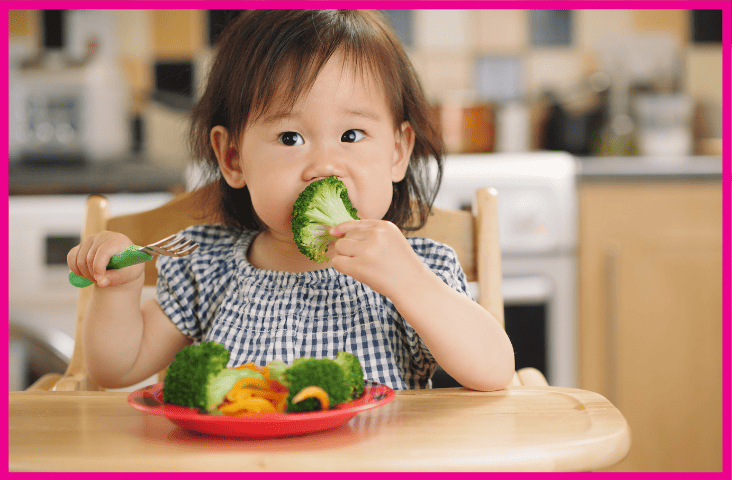
Raising Healthy Eaters: Nourishing our children for the decades to come
It’s easy to focus on the day-to-day details of what our children eat. We can see food’s more immediate effects, such as grumpiness after missing snack time, or the importance of a well-nourished immune system to avoid coughs and colds. However, it’s also vital to remember the ‘long game’ – a key part of feeding our children is setting the groundwork for them to become adults who eat well, promoting their health far into the future.
In this blog, I’m going through my ten top tips for helping our little munchkins grow into healthy adults, even though that seems a very long time away!
1) Begin at the beginning. While the age of 7 or 8 months seems very young to start establishing healthy eating habits and convincing children to ‘eat their veg’, it’s the perfect time to begin. When starting to wean babies it may seem easier to stay with sweeter flavours, such as fruit purées. However, introducing vegetable purees early can help them to be accepted. Remember that babies may need to taste a new food up to ten times before they decide they like it, so some persistence may be needed! (Be sure to refer to current official weaning guidelines for appropriate ages and stages to introduce different foods and textures.)
2) Treat foods should be treats. We live in a world that is literally designed to help us to eat unhealthily (thanks to people such as supermarket designers and fast-food advertising gurus). From tempting sweets by the supermarket cash register to birthday parties to massive multipacks of chip packets, treat foods can creep into our children’s eating patterns at every turn. While it can feel like we’re saying ‘no’ almost every minute, it is essential to keep a tight rein on the treat foods. This is how our children learn that they’re special foods and not for every day. For example, in our house we make the chip multipacks a weekend treat and not a weekday food.

3) Be the eater you want your child to become. While it’s easy to tell our little ones what they should eat, research has shown that children are more likely to copy their parents’ behaviour. If we want our children to become adults who eat plenty of vegetables and choose water rather than sugary drinks, for instance, then this is the example we need to show them.
4) Make healthy choices the easy choices – for both of you. Eating healthily can be challenging. Make it easier by having a refrigerator and cupboard stocked with healthy snacks and ingredients. Shortcuts such as frozen veg, pre-chopped meat, ready-made stir-fry sauces, and bags of salad make it a snap to put a nutritious meal on the table. And taking healthier snacks such as fruit or muesli bars (look for those with less sugar) when you’re on the go can help you avoid a less nutritious and more expensive choice when hunger pangs strike.
5) Eat together. Our busy lives can make it difficult to sit down to a meal together, but research has clearly shown a wide range of benefits from family meals. These range from nutritional benefits, such as children eating more vegetables, to mental health, such as lower rates of stress in teens. The habit of eating together tends to keep going as families grow older, so it’s never too early to make it a priority. Family schedules can make it tricky though. If it’s tough to eat together on a daily basis, choose a couple of meals a week and make a special effort to connect then.

6) Quench thirst with water. Make it a habit for all the family to reach for water to quench thirst, keeping sweet drinks for an occasional treat. Try a squeeze of lemon or a few crushed mint leaves to add a zing of flavour. For special occasions, ice cubes set with frozen melon, berries and other colourful fruits will make the water jug much more fun.
7) Allow some fussiness but seek help if necessary. Eating a range of different foods is essential for good health, but it’s not necessary that our children enjoy every single food. As adults we may not be keen on, for example, green beans or broccoli. Because there are other foods with similar nutrients, we can make up for this. Thus, so long as we eat a range of other green veggies, we don’t have to eat beans and broccoli. Similarly, I don’t think it’s a problem for our youngsters to have a few foods they’re not keen on. However, if there are a lot of foods your child is avoiding, particularly if it’s an entire food group like dairy foods or all fruit and vegetables, there can be concerns about nutrition and other issues. If you’re worried, it can be useful to talk to your child’s doctor or a dietitian.
8) Respect children’s appetites. It’s only natural that we like to see our kids eat the food we serve them, and might be tempted to ask them to finish what’s on their plate. However, if children aren’t allowed to stop eating when their tummies tell them to, they may stop paying attention to whether they’re full or not. Stopping eating when we’re full is a vital part of the system that helps prevent us from gaining too much weight. There are two great ways to help our children eat most of the food on their plate without us asking. Don’t give snacks close to the mealtime, to ensure they are hungry. Also, offer a smallish main meal, and give the option of a second helping if they want it.

9) Emphasise exercise and activity. We know there are a multitude of benefits to exercise, from helping us sleep better to reducing the risk of becoming overweight. Many of these benefits are relevant to both children and parents and carers, making it even more beneficial to be active together if possible. (This also relates back to number 3, setting a great example.) Early childhood is the perfect time for our little ones to get into the habit of regular activity and introduce different sports. And great family activity ideas include a trip to the pool or water park, kicking a ball around the backyard or even putting on music and dancing around the kitchen while you’re cooking!
10) Introduce lots of flavours and new foods. Following on from my first point of introducing a variety of healthy flavours at the beginning of your child’s food journey…don’t stop! Eating a wide range of foods will help us get the different nutrients, such as vitamins and minerals, our bodies require. It may also turn kids in the direction of being less fussy. Trying to get your little one interested in tasting new foods? Try shopping together and choosing something they’ve never tried from the fruit and veg section. You could also cook a simple recipe together, or even grow a vegetable – beans are easy and quick to grow. A great place to start!
© Fiona Hinton 2024
MEDICAL DISCLAIMER: Please note that this blog is for general information only, and should not be taken as a substitute for qualified medical advice. Please discuss medical issues with your child’s doctor before taking any action.
About Fiona: Fiona Hinton is a dietitian, but describes herself as a nutrition translator, taking the science of nutrition and translating it into foods we love to eat, to nourish both body and soul. She has over 20 years of experience as a dietitian, working in a wide range of areas from hospital wards to running her own private practice. Fiona has a special interest in children’s nutrition. As a mum of three school-age boys, she has first-hand experience of the issues associated with feeding young children, such as weaning and fussiness. Fiona specialises in real-life strategies and practical suggestions to convert nutrition advice into food kids will eat. Fiona has collaborated on several books, including one with best-selling children’s food writer Annabel Karmel, as well as training childcare staff in children’s nutrition.


